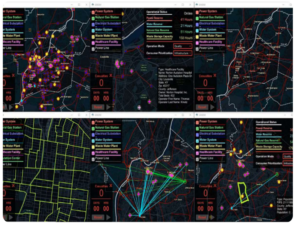GINOM | The Global Infrastructure Network Optimization Model
The Need for GINOM Situational Awareness and Decision Support System
In the chaos of a large-scale power outage, all other infrastructures and services, in all sectors, will shut down. Restoring and restarting electric grids and other lifeline infrastructures in such a scenario is a particularly complex, manual, labor-intensive effort requiring weeks or months to resolve. And before restoration can begin, assessment and repair of relevant equipment and facilities will be essential, for both the power grid and for other grid-critical infrastructures, suppliers, and customers. Without mission-optimized guidance, the assessment, repair, and restoration process will likely take place far too late to sustain the lives of affected populations.
Why is this the case?
With both extreme natural hazards and manmade threats increasing, electric grids, microgrids, and their supply chains are increasingly vulnerable to attack and disruption, making preplanned resilience critical to recovery. Yet in today’s reality of closely coupled, interconnected infrastructures, resilience will depend on a wide array of interdependent resources, services, and supply chains (e.g., communications, fuel and rework equipment resupply, transport, etc.). This makes it nearly impossible for operators to project the primary, secondary, and tertiary consequences of repair or restoration choices they make, as they navigate the chaos of an extreme, large-scale power cut.
A true, real-time “digital twin” of the operating systems of interdependent grids/microgrids and their suppliers could be used to resolve this concern, with a computerized system racing through that digital duplicate to recommend mission-prioritized actions. However, extraordinary complexity, fast-changing configurations, and security and proprietary issues have stalled progress in developing a massive, real-time digital duplicate of the operating systems of interdependent infrastructures and suppliers.
Enter GINOM situational awareness system.
GINOM – An out-of-the-box, emerging solution to the chaos of Black Sky catastrophes
A true, real-time digital duplicate of interdependent infrastructures and suppliers would give operators in all sectors the situational awareness and decision support they’ll need to find a successful path among the myriad dead ends in chaotic, highly disrupted scenarios. But if developing and maintaining a massive “mega-model” of many fast-changing, proprietary corporations is impractical, what can be done?
The GINOM situational awareness system takes a revolutionary, out-of-the-box approach to resolving this critical problem. Rather than attempting a massive digital duplicate of all interdependent stakeholders, GINOM simply provides a hosting framework for all players to functionally interconnect and then data-mines that interconnected, functional (non-proprietary) network for both situational awareness and decision support. This, alongside black sky resilience exercise programs, can be the key to securing our future.
GINOM | What’s inside the Box?
In the chaotic environment of a large-scale power cut, situational awareness and AI-optimized decision support will be essential enablers for power grid blackstart and FOB microgrid restoration, making it possible for grid-critical interdependent stakeholders to orchestrate and prioritize their efforts – in advance and in real-time – as part of the complex repair and restoration process. These capabilities will be particularly critical to support rapid recovery, and meet population sustainment restoration timelines.
The GINOM situational awareness platform, currently at a prototype development level, is structured to enable precisely these capabilities.
Top Level Description
GINOM is an innovative, disruptive chaos management platform, often referred to as a Multicorporate simulation Operating System (MOS). Structured to operate as a fully interactive digital twin, the platform offers both ahead-of-time grid/microgrid disruption planning, training and exercise support, and AI-guided decision support for power grid/microgrid operators and their counterparts in all sectors in complex catastrophes. A unique critical infrastructure simulation operating system, GINOM is a first-of-its-kind MOS. Under development at EIS Council for six years, it currently operates at a prototype level, based on competitive grants awarded by the Israel Ministry of Energy and multiple US foundations.
As a critical feature, GINOM provides a true, real-time “digital twin” of the operating systems or simulations of many interdependent organizations, which may also be integrated with threat or resource simulations and related models. These features, critical to the resilience of a power grid and other interdependent infrastructures, are made possible by a completely different approach from earlier, unsuccessful efforts at multi-infrastructure digital twin development – i.e., developing computationally massive, compound duplications of all interdependent infrastructures.
Recognizing the inherent complexity, severe scalability limits, and proprietary issues with this earlier approach, GINOM is designed to operate by guided functional integration of an essentially unlimited number of organizations’ operating systems or simulations, rather than by attempting to digitally duplicate them. By utilizing exclusively high-level functional information, there is no need for proprietary or sensitive information sharing in its operation.
Detailed Description
GINOM is a large-scale, network-native, multi-sector, critical infrastructure simulation operating system based on techniques from agent-based simulation and discrete-event simulation. It is designed to run on EMP-hardened hardware with data routed over dark fiber or ad hoc mesh networks.
* Screenshot of multi-infrastructure operator interface from current GINOM Prototype.
Three features are particularly fundamental to the platform’s performance, scalability, and – critically important – its feasibility:
- Guided, functional connectivity: With its architecture designed to provide guided, functional connectivity of infrastructure operating systems, there is no need to attempt to digitally duplicate such operating systems. As a fundamental, related structural feature, the system provides for both time and network coordination.
- Flexible computational workers: The platform is also structured to utilize computational workers that can run either in the cloud or on distributed users’ devices.
- Patented approach for practical scalability: Given the fast-growing interdependencies that characterize both civilian and military infrastructures, scalability will be critical. In addition to the inherent scalability advantages of its functional integration architecture and its use of flexible computational workers, the GINOM team developed and patented a powerful technique, now built into the platform. The “Inverse interest management architecture” methodology has become a key enabler, minimizing network usage even further than these inherent architectural features. Patents: Interest-Based Distributed Simulation System – US 10,956,631 B1 and US 11,111,152 B2.
Together, these unique, disruptive architectural and design features give GINOM essentially unlimited scalability, with no need for unique computer assets. This will be key to the platform’s continuing utility, and to meeting the goals of DIANA’s Energy Challenge, enabling the system to continue to evolve and grow to integrate an increasing number of interdependent infrastructures, suppliers, and other stakeholder organizations and scenario models, and to address a growing range and scale of energy infrastructure disaster scenarios.
Key Features
-
Functional Integration
Functional integration is fundamental to the success of GINOM’s architecture, enabling functional integration of an unlimited number of organizations’ operating systems or simulations into a single environment. These operating systems or simulations can run on an organization’s own secure, audited hardware while still participating in a larger-scale GINOM simulation. Only high-level functional information required by the simulation scenario is shared, with no need to exchange low-level details or data that might be sensitive, proprietary, or classified.
In preparation for use with multiple corporate operating systems or simulations, GINOM® currently incorporates notional simulation applications for seven infrastructure systems: electric, natural gas, emergency fuel, health care, water, wastewater, population center, transport, and a basic pandemic simulation. In each case, it accounts for geographic layout and interdependencies, allowing for the simulation of complex phenomena such as cascading failures in extreme scenarios.
-
Enables relationship-based projections of large-scale catastrophes

One feature that sets GINOM® apart from other infrastructure simulations is that its agent-based structure does not just rely on historical data, and projecting such data into the future. The platform is GIS-based and data-informed. In contrast to data-driven techniques (dashboards) or data-hungry machine learning methods, it takes account of the relationships among different facilities and their dynamic behavior, allowing it to simulate and predict events that have never occurred.
This is particularly important for decision support in complex catastrophe scenarios. Since it is impossible to train a data-driven AI or machine learning model to predict massive, cascading infrastructure failures that have never happened before there is no data to use to train such models. GINOM can capture such phenomena. Not only, does this secure our chances of preparing for catastrophic events, but also ensures our black sky recovery efforts are unmatched.
-
Operates as a true “digital twin” with unlimited scalability
The GINOM situational awareness system is designed to ultimately function as a “digital twin.” It can incorporate and integrate real-time data from functioning systems, SCADA systems, and other sensing or control systems together with simulated data generated by simulation apps. Crucially, the simulations can respond to this real-time data, allowing GINOM® to combine “situational awareness” with predictive modeling into a powerful in-advance or real-time decision support tool.
-
GINOM Situational Awareness Technology
Technologically speaking, GINOM’s backend, which is responsible for simulating facilities and entities, is written in the Scala programming language, which runs on the Java Virtual Machine (JVM) or can be compiled into native code. The backend service can be scaled up as server hardware capabilities are increased or can scale out as more servers are added to the compute pool.
GINOM’s frontend is also written in Scala and runs on Scalajs, a Scala-to-Javascript transpiler that makes Scala code executable in web browsers and other web technologies and makes interoperation with Javascript and related technologies – especially web components – straightforward. The front end uses the Mapbox GL JS library for GIS and maps, with a PixiJS overlay for icon display and animation. Both can take advantage of WebGL when it is available on the client, allowing for high-performance execution on end-user GPUs.
Create Impact with us:
Join our membership and
contribution programs
Participate in our
upcoming events:
Schedule a call with
our experts:
Advancing Earthquake Resilience: Strategic Urban Planning and Global Partnerships
In an era where urban landscapes continue to sprawl and the frequency of natural disasters seems to be on the rise, the importance of building resilient cities has never been more pronounced. Earthquakes, in particular, pose a significant risk to densely populated areas, with the power to cause extensive damage and incur millions in damage […]
Cyber Resilience in the Energy Sector: Safeguarding the Grid from Digital Disruptions
In today’s interconnected world, the energy sector stands as a vital backbone of national and global infrastructures, facilitating everything from lighting our homes to powering industries. However, this sector is increasingly finding itself in the crosshairs of cybercriminals, making cyber resilience not just a matter of technological integrity but of national security. The concept of […]
The Role of Local Governments in Strengthening Infrastructure Resilience
The significance of local governments in strengthening infrastructure resilience cannot be understated. Often perceived as entities primarily focused on addressing routine community concerns and improvements, their responsibilities extend far beyond these day-to-day operations. In the realm of preparing for and mitigating the effects of large-scale, catastrophic events—referred to as “black sky” disasters—local governments emerge as […]



